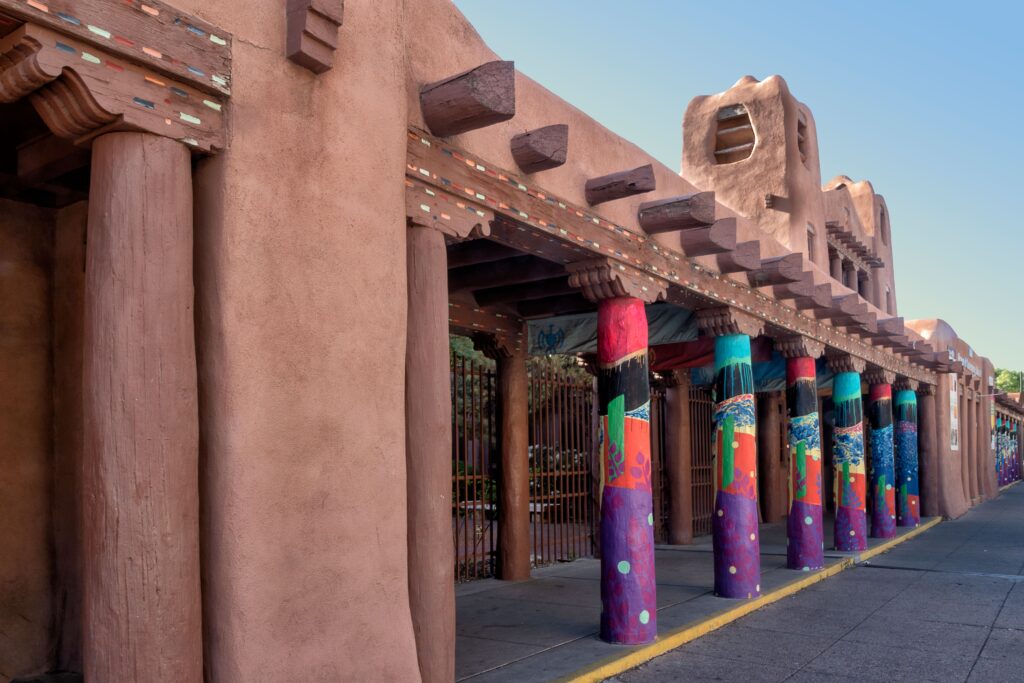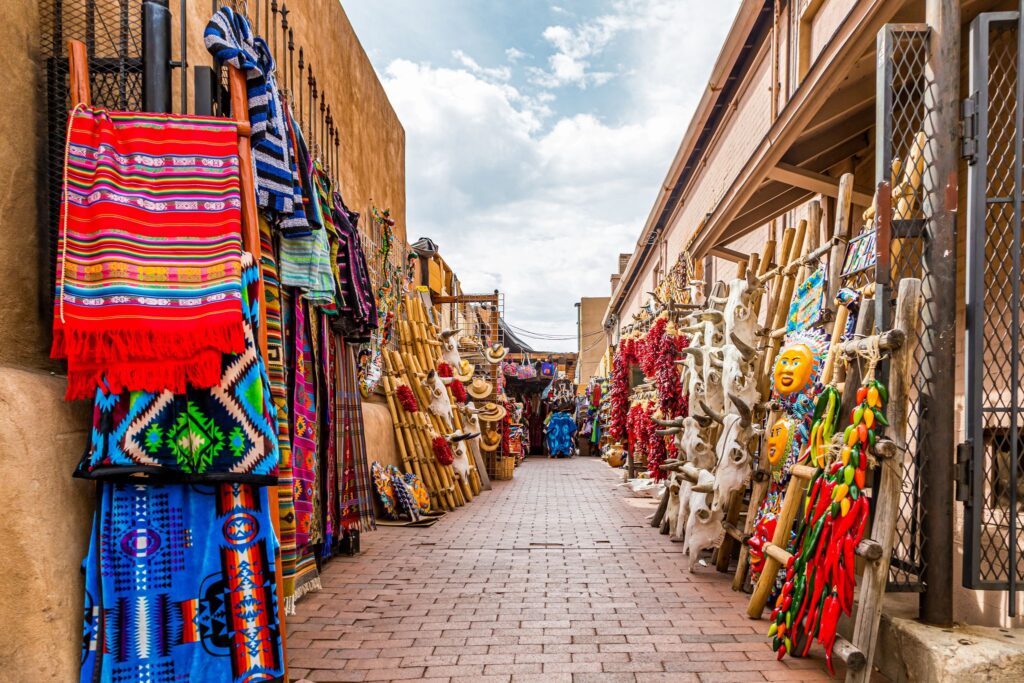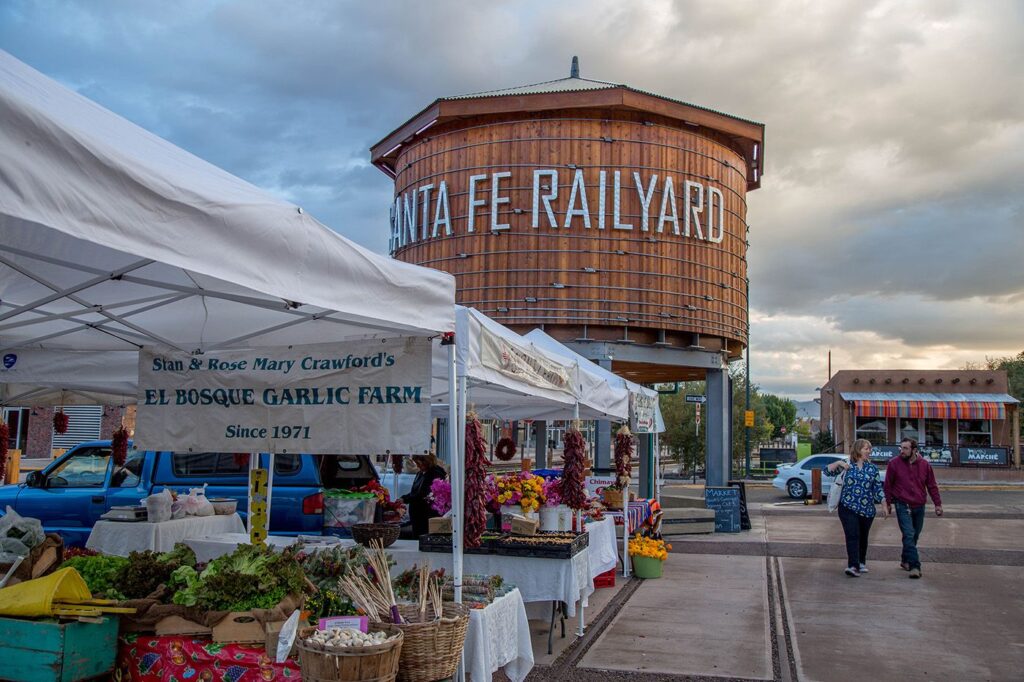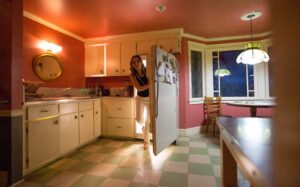The Jewish Traveler
Feature
The Splendor of Santa Fe

Standing on the threshold of the Cathedral Basilica of St. Francis during a pre-pandemic getaway, guide Stefanie Beninato asked if we could read the Hebrew inscription etched into the stone arch of the entrance. To the complete surprise of my husband, Ira, and me, we identified the Tetragrammaton, the four-letter biblical name for God found in the Bible. Modern historians cannot state with certainty why Archbishop John B. Lamy added the inscription to the church while it was being built between 1869 and 1887. However, most agree that two prominent Jewish families—the Spiegelbergs and the Staabs—had harmonious relationships with Lamy and made significant contributions to the church’s building at a time when Santa Fe’s Jewish community had yet to construct its own synagogue.
Established in 1610, Santa Fe is the oldest capital city in the United States. Located at over 7,000 feet above sea level, it is surrounded by the foothills of the Sangre de Cristo Mountains and vibrantly intertwines Hispanic, Anglo and Native American cultures—a unique admixture that explains its official nickname, “The City Different.” Diverse art, adobe architecture, innovative southwestern cuisine, outdoor adventures, spa retreats and seasonal festivals are main draws. And there has been a Jewish presence here for almost 200 years.
Since the early 1980s, that presence, whose origins lie with German immigrants, has been enriched by the slow emergence of those who claim descent from crypto-Jews—Spanish and Portuguese Jews who were forced to convert to Christianity during the Inquisition, but who secretly maintained Jewish customs. These men and women, who generally maintain a low profile in the community, claim Sephardic ancestry overlaid with centuries of Hispanic culture.
In the 1840s, like others heading to the rugged New Mexico Territory, hardy Jewish pioneers such as Solomon Jacob Spiegelberg set out along the 775-mile Cimarron Cutoff for the Santa Fe Trail—a trip that took almost 10 weeks. Upon reaching Santa Fe, these Jews, mostly single men, opened shops, served as quartermasters and civilian merchants for the United States Army and traded with local Native American tribes.
By 1848, Spiegelberg was joined by his brother Levi. The two became wholesale merchants and, after the arrival of four more brothers, the House of Spiegelberg expanded to include numerous banking, mining, insurance and real estate concerns.
Santa Fe’s Jews intermingled with their neighbors and supported secular organizations like the Freemasons and Odd Fellows. Surprisingly, they didn’t construct a synagogue until the mid-20th century, nor did they create Jewish communal institutions. Some Jews were buried among their fellow citizens. In the 1990s, Santa Fe’s Memorial Garden Cemetery opened a Jewish section.
In the 19th century, Jews gathered in private homes to celebrate Jewish holidays and b’nei mitzvot. A Denver mohel periodically performed brit milah ceremonies. By 1880, approximately 70 Jews, less than 1 percent of the total population, lived in Santa Fe County. Despite their miniscule numbers, they comprised 12 percent of the merchants who owned stores on or near the Plaza, the historic main square in downtown Santa Fe. Generations later, these once Jewish-owned stores now house souvenir, jewelry and other shops.

Today, a few blocks east of the Plaza, the Peyton Wright Gallery occupies the onetime home of late-arriving Spiegelberg brother Willi and his wife, Flora. Built in 1880, the two-story adobe building is topped with a sloped metal roof and features 10-inch-thick walls. It was the first residence in Santa Fe to install indoor plumbing and gaslights.
Across the street from the gallery, Julia and Abraham Staab’s former residence is today La Posada de Santa Fe Resort & Spa, where visitors will encounter a mezuzah as they enter through the mahogany double doors. Original parquet floors, leaded crystal chandeliers and stained-glass windows attest to the family’s immense wealth, accumulated through merchant trade. Legends abound that the ghost of Julia Staab haunts the property, and stories of sightings have been explored in Unsolved Mysteries and other television series.
“These individuals and families put and kept Santa Fe on the map and helped the city grow,” said Linda Goff, president of the New Mexico Jewish Historical Society. “As civic-minded people, they established the first banks, were politically active and, through their generosity, helped people in need.”
New Mexico’s wilderness was forever changed in the mid-20th century with the building of a U.S. Air Force base in Albuquerque, an hour from Santa Fe, and the once-secret nuclear research facility at Los Alamos, 30 minutes away. In 1956, with an influx of Jews to the region, the Santa Fe community dedicated its first synagogue, the Santa Fe Jewish Temple, which is today known as Temple Beth Shalom—a Reform congregation with 350 member households. The city, with as many as 6,000 Jews according to a 2015 survey conducted by the Jewish Federation of New Mexico, claims an additional four synagogues as well as a Hadassah chapter.

When my husband and I visited Temple Beth Shalom, Rabbi Neil Amswych drew our attention to the vibrant stained-glass ner tamid in the sanctuary that was created by local Jewish artist and synagogue member Bette Yodell. We also stopped to admire the so-called Las Vegas Scroll, the first Torah to enter the New Mexico Territory. It originally had a home in Congregation Montefiore in Las Vegas, N.M., which, in 1884, became the territory’s first synagogue. Attention had temporarily shifted to Las Vegas around that time, after the Atchison, Topeka and Santa Fe Railway created a stop in the town. In the 1920s, with the introduction of Route 66 passing through Taos, Santa Fe and Albuquerque, Las Vegas lost its popularity. Congregation Montefiore eventually closed in the 1950s.
Before leaving town, visitors to Santa Fe should view the paintings of Jewish artist Sara Novenson, whose gallery is located near the San Miguel Chapel, the oldest church in the continental United States. Using the majestic landscape of the Sangre de Cristo foothills, Novenson transforms the ordinary into the spiritual by employing a complimentary mix of radiant colors and Hebrew calligraphy. Her years of studying Jewish texts shine through her work, especially her many depictions of biblical women.
Hers is just the sort of artistic endeavor coupled with spiritual curiosity that typifies the unique appeal of Santa Fe.
WHAT TO SEE
New Mexico History Museum
The institution’s core exhibit, “Telling New Mexico: Stories from Then and Now,” showcases the region’s diverse history from prehistoric times to the present. Exhibits relating to the history of the Santa Fe Trail and Fred Harvey restaurants and hotels display Jewish artifacts connected to prominent local Jews, including the Spiegelbergs, the Staabs and Herman Schweizer, one of the largest and most influential collectors of Native American art in the first half of the 20th century.

The millennials behind the Meow Wolf collaborative took giant steps away from traditional art forms when they created the House of Eternal Return, an interactive, immersive installation. I felt like Alice in Wonderland stepping into the rabbit hole when I walked through a refrigerator door leading to a series of over 70 fantastically decorated rooms.
Museum Hill
In Santa Fe, visitors have the convenience of visiting several top-rated attractions in one place. At Museum Hill, it’s possible to spend time outside in a botanical garden and also enjoy hours inside learning about Native American art, Spanish Colonial art and folk art.
Canyon Road Arts District
Put on a pair of comfortable shoes and grab a bottle of water before meandering along this famous road filled with more than 80 local, domestic and international art galleries. Parking is limited.
Georgia O’Keeffe Museum
The celebrated artist’s talents and progressive lifestyle entice art lovers at the small Georgia O’Keeffe Museum. A worthwhile and enlightening video highlights O’Keeffe’s achievements and her nontraditional relationship with Alfred Stieglitz, a prominent and influential American Jewish photographer and art promoter.
Farmers’ Market
Sunset magazine included the Santa Fe Farmers’ Market in their list of the “Top 10 Farmers’ Markets.” Local farmers and vendors line the platform running next to the railroad tracks selling their locally sourced products.
Sandy Bornstein is an award-winning travel writer and author based in Colorado (thetravelingbornsteins.com). Her trip was sponsored by the city of Santa Fe.










 Facebook
Facebook Instagram
Instagram Twitter
Twitter
Leave a Reply